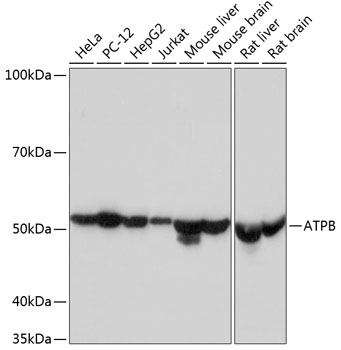Metabolism Antibodies 3
Anti-ATPB Antibody (CAB11214)
- SKU:
- CAB11214
- Product Type:
- Antibody
- Reactivity:
- Human
- Reactivity:
- Mouse
- Reactivity:
- Rat
- Host Species:
- Rabbit
- Isotype:
- IgG
- Antibody Type:
- Monoclonal Antibody
- Research Area:
- Metabolism
Description
| Antibody Name: | Anti-ATPB Antibody |
| Antibody SKU: | CAB11214 |
| Antibody Size: | 20uL, 50uL, 100uL |
| Application: | WB IHC IF |
| Reactivity: | Human, Mouse, Rat |
| Host Species: | Rabbit |
| Immunogen: | A synthesized peptide derived from human ATPB |
| Application: | WB IHC IF |
| Recommended Dilution: | WB 1:500 - 1:2000 IHC 1:50 - 1:200 IF 1:50 - 1:200 |
| Reactivity: | Human, Mouse, Rat |
| Positive Samples: | HeLa, PC-12, HepG2, Jurkat, Mouse liver, Mouse brain, Rat liver, Rat brain |
| Immunogen: | A synthesized peptide derived from human ATPB |
| Purification Method: | Affinity purification |
| Storage Buffer: | Store at -20°C. Avoid freeze / thaw cycles. Buffer: PBS with 0.02% sodium azide, 0.05% BSA, 50% glycerol, pH7.3. |
| Isotype: | IgG |
| Sequence: | Email for sequence |
| Gene ID: | 506 |
| Uniprot: | P06576 |
| Cellular Location: | Mitochondrion, Mitochondrion inner membrane |
| Calculated MW: | 50kDa |
| Observed MW: | 57KDa |
| Synonyms: | ATPMB, ATPSB, HEL-S-271 |
| Background: | This gene encodes a subunit of mitochondrial ATP synthase. Mitochondrial ATP synthase catalyzes ATP synthesis, utilizing an electrochemical gradient of protons across the inner membrane during oxidative phosphorylation. ATP synthase is composed of two linked multi-subunit complexes: the soluble catalytic core, F1, and the membrane-spanning component, Fo, comprising the proton channel. The catalytic portion of mitochondrial ATP synthase consists of 5 different subunits (alpha, beta, gamma, delta, and epsilon) assembled with a stoichiometry of 3 alpha, 3 beta, and a single representative of the other 3. The proton channel consists of three main subunits (a, b, c). This gene encodes the beta subunit of the catalytic core. [provided by RefSeq, Jul 2008] |
| UniProt Protein Function: | ATP5B: Mitochondrial membrane ATP synthase (F(1)F(0) ATP synthase or Complex V) produces ATP from ADP in the presence of a proton gradient across the membrane which is generated by electron transport complexes of the respiratory chain. F-type ATPases consist of two structural domains, F(1) - containing the extramembraneous catalytic core, and F(0) - containing the membrane proton channel, linked together by a central stalk and a peripheral stalk. During catalysis, ATP synthesis in the catalytic domain of F(1) is coupled via a rotary mechanism of the central stalk subunits to proton translocation. Subunits alpha and beta form the catalytic core in F(1). Rotation of the central stalk against the surrounding alpha(3)beta(3) subunits leads to hydrolysis of ATP in three separate catalytic sites on the beta subunits. Belongs to the ATPase alpha/beta chains family. |
| UniProt Protein Details: | Protein type:EC 3.6.3.14; Hydrolase; Mitochondrial; Energy Metabolism - oxidative phosphorylation Chromosomal Location of Human Ortholog: 12q13.13 Cellular Component: cell surface; membrane; mitochondrial matrix; mitochondrial membrane; mitochondrial proton-transporting ATP synthase complex; mitochondrion; nucleus; plasma membrane Molecular Function:ATPase activity; hydrogen ion transporting ATPase activity, rotational mechanism; MHC class I protein binding; protein binding; transmembrane transporter activity Biological Process: angiogenesis; ATP biosynthetic process; mitochondrial ATP synthesis coupled proton transport; mitochondrion organization and biogenesis; osteoblast differentiation; proton transport; regulation of intracellular pH |
| NCBI Summary: | This gene encodes a subunit of mitochondrial ATP synthase. Mitochondrial ATP synthase catalyzes ATP synthesis, utilizing an electrochemical gradient of protons across the inner membrane during oxidative phosphorylation. ATP synthase is composed of two linked multi-subunit complexes: the soluble catalytic core, F1, and the membrane-spanning component, Fo, comprising the proton channel. The catalytic portion of mitochondrial ATP synthase consists of 5 different subunits (alpha, beta, gamma, delta, and epsilon) assembled with a stoichiometry of 3 alpha, 3 beta, and a single representative of the other 3. The proton channel consists of three main subunits (a, b, c). This gene encodes the beta subunit of the catalytic core. [provided by RefSeq, Jul 2008] |
| UniProt Code: | P06576 |
| NCBI GenInfo Identifier: | 114549 |
| NCBI Gene ID: | 506 |
| NCBI Accession: | P06576.3 |
| UniProt Secondary Accession: | P06576,Q14283, A8K4X0, |
| UniProt Related Accession: | P06576 |
| Molecular Weight: | 56,560 Da |
| NCBI Full Name: | ATP synthase subunit beta, mitochondrial |
| NCBI Synonym Full Names: | ATP synthase, H+ transporting, mitochondrial F1 complex, beta polypeptide |
| NCBI Official Symbol: | ATP5B |
| NCBI Official Synonym Symbols: | ATPMB; ATPSB; HEL-S-271 |
| NCBI Protein Information: | ATP synthase subunit beta, mitochondrial |
| UniProt Protein Name: | ATP synthase subunit beta, mitochondrial |
| UniProt Gene Name: | ATP5B |
| UniProt Entry Name: | ATPB_HUMAN |







